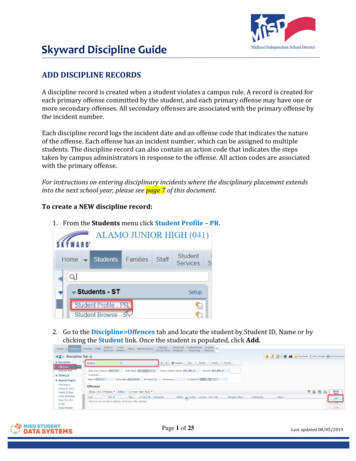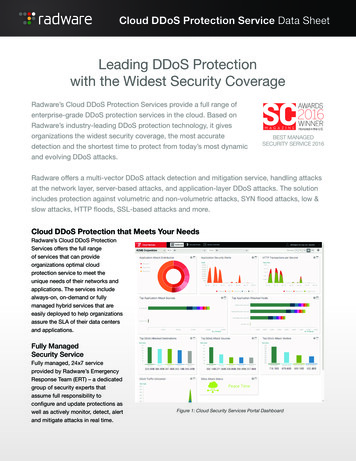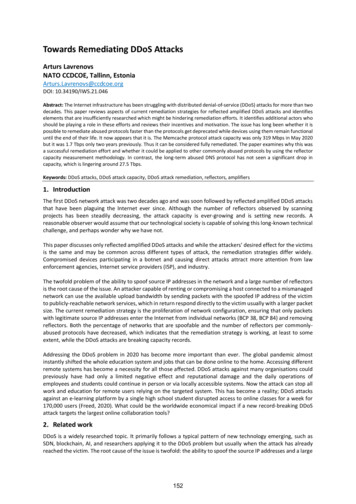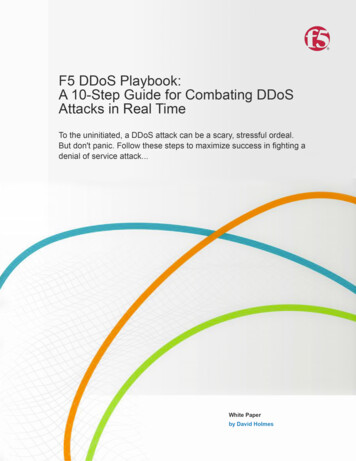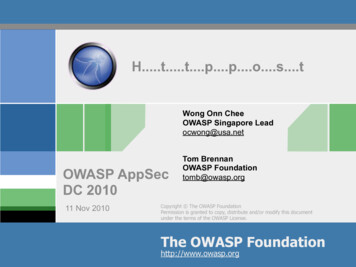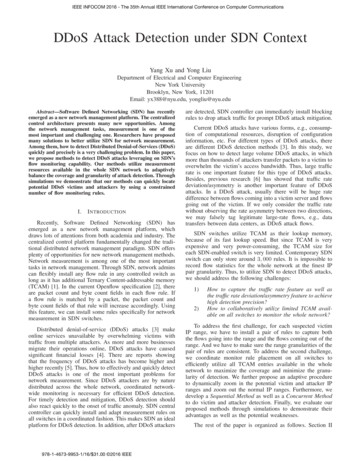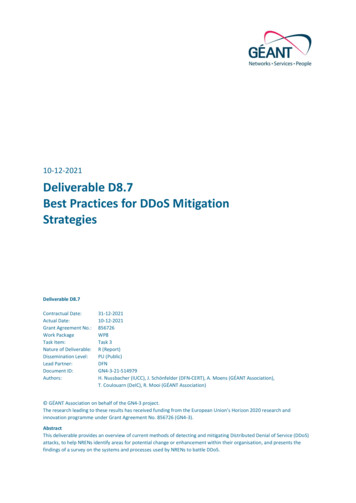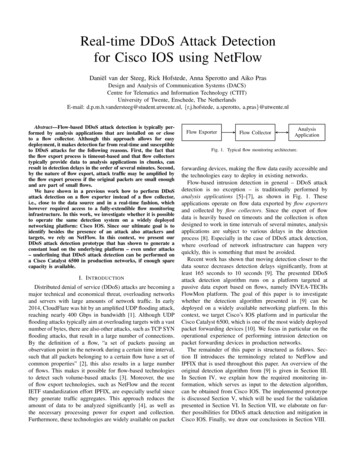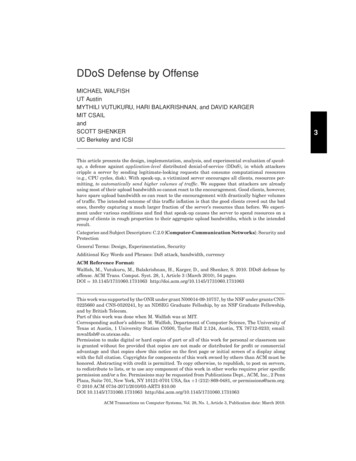
Transcription
DDoS Defense by OffenseMICHAEL WALFISHUT AustinMYTHILI VUTUKURU, HARI BALAKRISHNAN, and DAVID KARGERMIT CSAILandSCOTT SHENKERUC Berkeley and ICSIThis article presents the design, implementation, analysis, and experimental evaluation of speakup, a defense against application-level distributed denial-of-service (DDoS), in which attackerscripple a server by sending legitimate-looking requests that consume computational resources(e.g., CPU cycles, disk). With speak-up, a victimized server encourages all clients, resources permitting, to automatically send higher volumes of traffic. We suppose that attackers are alreadyusing most of their upload bandwidth so cannot react to the encouragement. Good clients, however,have spare upload bandwidth so can react to the encouragement with drastically higher volumesof traffic. The intended outcome of this traffic inflation is that the good clients crowd out the badones, thereby capturing a much larger fraction of the server’s resources than before. We experiment under various conditions and find that speak-up causes the server to spend resources on agroup of clients in rough proportion to their aggregate upload bandwidths, which is the intendedresult.Categories and Subject Descriptors: C.2.0 [Computer-Communication Networks]: Security andProtectionGeneral Terms: Design, Experimentation, SecurityAdditional Key Words and Phrases: DoS attack, bandwidth, currencyACM Reference Format:Walfish, M., Vutukuru, M., Balakrishnan, H., Karger, D., and Shenker, S. 2010. DDoS defense byoffense. ACM Trans. Comput. Syst. 28, 1, Article 3 (March 2010), 54 pages.DOI 10.1145/1731060.1731063 http://doi.acm.org/10.1145/1731060.1731063This work was supported by the ONR under grant N00014-09-10757, by the NSF under grants CNS0225660 and CNS-0520241, by an NDSEG Graduate Felloship, by an NSF Graduate Fellowship,and by British Telecom.Part of this work was done when M. Walfish was at MIT.Corresponding author’s address: M. Walfish, Department of Computer Science, The University ofTexas at Austin, 1 University Station C0500, Taylor Hall 2.124, Austin, TX 78712-0233; email:mwalfish@ cs.utexas.edu.Permission to make digital or hard copies of part or all of this work for personal or classroom useis granted without fee provided that copies are not made or distributed for profit or commercialadvantage and that copies show this notice on the first page or initial screen of a display alongwith the full citation. Copyrights for components of this work owned by others than ACM must behonored. Abstracting with credit is permitted. To copy otherwise, to republish, to post on servers,to redistribute to lists, or to use any component of this work in other works requires prior specificpermission and/or a fee. Permissions may be requested from Publications Dept., ACM, Inc., 2 PennPlaza, Suite 701, New York, NY 10121-0701 USA, fax 1 (212) 869-0481, or permissions@acm.org.!C 2010 ACM 0734-2071/2010/03-ART3 10.00DOI 10.1145/1731060.1731063 http://doi.acm.org/10.1145/1731060.1731063ACM Transactions on Computer Systems, Vol. 28, No. 1, Article 3, Publication date: March 2010.3
3:2 M. Walfish et al.1. INTRODUCTIONThis article is about a defense to application-level Distributed Denial of Service (DDoS), a particularly noxious attack in which computer criminals mimiclegitimate client behavior by sending proper-looking requests, often via compromised and commandeered hosts [Ratliff 2005; SecurityFocus 2004; cyberslam 2004; Handley 2005], known as bots. By exploiting the fact that manyInternet servers have “open clientele”—that is, they cannot tell whether aclient is good or bad from the request alone—the attacker forces the victimserver to spend much of its resources on spurious requests. For the savvy attacker, the appeal of this attack over a link flood or TCP SYN flood is twofold.First, far less bandwidth is required: the victim’s computational resources—disks, CPUs, memory, application server licenses, etc.—can often be depletedby proper-looking requests long before its access link is saturated. Second, because the attack traffic is “in-band,” it is harder to identify and thus more potent.Examples of such (often extortionist [Register 2003; Network World 2005]) attacks include HTTP requests for large files [SecurityFocus 2004; Ratliff 2005],making queries of search engines [cyberslam 2004], and issuing computationally expensive requests (e.g., database queries or transactions) [Kandula et al.2005].Current DDoS defenses try to slow down the bad clients. Though we stand insolidarity with these defenses in the goal of limiting the service that attackersget, our tactics are different. We ask all clients to speak up, rather than sit idlyby while attackers drown them out. We rely on encouragement (a term madeprecise in Section 4.1), whereby the server causes a client, resources permitting,to automatically send a higher volume of traffic. The key insight of this defenseis as follows: we suppose that bad clients are already using most of their uploadbandwidth, so they cannot react to the encouragement, whereas good clientshave spare upload bandwidth, so they can send drastically higher volumes oftraffic. As a result, the traffic into the server inflates, but the good clients aremuch better represented in the traffic mix than before and thus capture a muchlarger fraction of the server’s resources than before.1.1 Justification and PhilosophyTo justify this approach at a high level and to explain our philosophy, wenow discuss three categories of defense. The first approach that one mightconsider is to overprovision massively: in theory, one could purchase enoughcomputational resources to serve both good clients and attackers. However,anecdotal evidence [Google Captcha 2005; Network World 2005] suggests thatwhile some sites provision additional link capacity during attacks using commercial services1, 2 , even the largest Web sites try to conserve computationby detecting bots and denying them access, using the methods in the secondcategory.1 http://www.prolexic.com.2 http://www.counterpane.com/ddos-offerings.html.ACM Transactions on Computer Systems, Vol. 28, No. 1, Article 3, Publication date: March 2010.
DDoS Defense by Offense 3:3We call this category—approaches that try to distinguish between good andbad clients—detect-and-block. Examples are profiling by IP address (a box infront of the server or the server itself admits requests according to a learneddemand profile)3, 4, 5 ; profiling based on application-level behavior (the serverdenies access to clients whose request profiles appear deviant [Ranjan et al.2006; Srivatsa et al. 2006]); and CAPTCHA-based defenses, which preferentiallyadmit humans [von Ahn et al. 2004; Kandula et al. 2005; Morein et al. 2003;Gligor 2003; Google Captcha 2005]. These techniques are powerful becausethey seek to block or explicitly limit unauthorized users, but their discriminations can err. Indeed, detection-based approaches become increasingly brittle as attackers’ mimicry of legitimate clients becomes increasingly convincing(see Section 9.2 for elaboration of this point).For this reason, our philosophy is to avoid telling apart good and bad clients.Instead, we strive for a fair allocation, that is, one in which each client is limited to an equal share of the server. With such an allocation, if 10% of theclients are “bad,” then those clients would be limited to 10% of the server’sresources, though of course the defense would not “know” that these clientsare “bad”.6 One might wonder what happens if 90% of the requesting clientsare bad. In this case, a fair allocation still accomplishes something, namelylimiting the bad clients to 90% of the resources. However, this “accomplishment” is likely insufficient: unless the server is appropriately overprovisioned,the 10% “slice” that the good clients can claim will not meet their demand.While this fact is unfortunate, observe that if the bad clients look exactlylike the good ones but vastly outnumber them, then no defense works. (Inthis case, the only recourse is a proportional allocation together with heavyoverprovisioning.)Unfortunately, in today’s Internet, attaining even a fair allocation is impossible. As discussed in Section 3, address hijacking (in which one client appearsto be many) and proxies (in which multiple clients appear to be one) prevent theserver from knowing how many clients it has or whether a given set of requestsoriginated at one client or many.As a result, we settle for a roughly fair allocation. At a high level, our approach is as follows. The server makes clients reveal how much of some resourcethey have; examples of suitable resources are CPU cycles, memory cycles, bandwidth, and money. Then, based on this revelation, the server should arrangethings so that if a given client has a fraction f of the clientele’s total resources,that client can claim up to a fraction f of the server. We call such an allocation a resource-proportional allocation. This allocation cannot be “fooled” by theInternet’s blurry notion of client identity. Specifically, if multiple clients “pool”3 http://mazunetworks.com.4 http://www.arbornetworks.com.5 http://www.cisco.com.6 Onemight object that this philosophy “treats symptoms”, rather than removing the underlyingproblem. However, eliminating the root of the problem—compromised computers and undergrounddemand for their services—is a separate, long-term effort. Meanwhile, a response to the symptomsis needed today.ACM Transactions on Computer Systems, Vol. 28, No. 1, Article 3, Publication date: March 2010.
3:4 M. Walfish et al.their resources, claiming to be one client, or if one client splits its resourcesover multiple virtual clients, the allocation is unchanged.Our approach is kin to previous work in which clients must spend someresource to get service [Dwork and Naor 1992; Dwork et al. 2003; Aura et al.2000; Juels and Brainard 1999; Abadi et al. 2005; Mankins et al. 2001; Wangand Reiter 2007; Back 2002; Feng 2003; Parno et al. 2007; Dean and Stubblefield2001; Waters et al. 2004; Stavrou et al. 2004]. We call these proposals resourcebased defenses. Ours falls into this third category. However, the other proposalsin this category neither articulate, nor explicitly aim for, the goal of a resourceproportional allocation.7The preceding raises the question: which client resource should the serveruse? This article investigates bandwidth, by which we mean available upstreambandwidth to the server. Specifically, when the server is attacked, it encouragesall clients to consume their bandwidth (as a way of revealing it); this behavioris what we had promised to justify earlier.A natural question is, “Why charge clients bandwidth? Why not charge themCPU cycles?” In Section 9.1.1, we give an extended comparison and show thatbandwidth has advantages (as well as disadvantages!). For now, we note thatone advantage of bandwidth is that it is most likely adversaries’ actual constraint. Moreover, many of this article’s contributions apply to both currencies;see Section 9.1.1.1.2 Speak-UpWe present these contributions in the context of speak-up, a system that defendsagainst application-level DDoS by charging clients bandwidth for access. Webelieve that our work [Walfish et al. 2005; Walfish et al. 2006] was the first toinvestigate this idea, though Sherr et al. [2005] and Gunter et al. [2004] sharethe same high-level motivation; see Section 9.1.The central component in speak-up is a server front-end that does the following when the server is oversubscribed: (1) rate-limits requests to the server; (2)encourages clients to send more traffic; and (3) allocates the server in proportionto the bandwidth spent by clients. This article describes several encouragementand proportional allocation mechanisms. Each of them is simple, resists gaming by adversaries, and finds the price of service (in bits) automatically withoutrequiring the front-end and clients to guess the correct price or communicateabout it. Moreover, these mechanisms apply to other currencies. The encouragement and proportional allocation mechanism that we implement and evaluateis a virtual auction: the front-end causes each client to automatically send acongestion-controlled stream of dummy bytes on a separate payment channel.When the server is ready to process a request, the front-end admits the clientthat has sent the most bytes.As a concrete instantiation of speak-up, we implemented the front-end forWeb servers. When the protected Web server is overloaded, the front-endgives JavaScript to unmodified Web clients that makes them send large HTTP7 An exception is a paper by Parno et al. [2007], which was published after our earlier work [Walfishet al. 2006]; see Section 9.1.ACM Transactions on Computer Systems, Vol. 28, No. 1, Article 3, Publication date: March 2010.
DDoS Defense by Offense 3:5POSTs. These POSTs are the “bandwidth payment.” Our main experimentalfinding is that this implementation meets our goal of allocating the protectedserver’s resources in rough proportion to clients’ upload bandwidths.1.3 How This Article is OrganizedThe article proceeds in two stages. The first stage is a quick overview. It consistsof the general threat and the high-level solution (this section), followed by responses to common questions (Section 2). The second stage follows a particularargument. Here is the argument’s outline.— We give a detailed description of the threat and of two conditions for addressing the threat (Section 3). The first of these conditions is inherent inany defense to this threat.— We then describe a design goal that, if met, would mitigate the threat—andfully defend against it, under the first condition (Section 4.1).— We next give a set of designs that, under the second condition, meet the goal(Section 4.2–Section 4.5).— We describe our implementation and our evaluation of that implementation;our main finding is that the implementation roughly meets the goal (Sections7–8).— At this point, having shown that speak-up “meets its spec,” we considerwhether it is an appropriate choice: we compare speak-up to alternativesand critique it (Section 9). And we reflect on the plausibility of the threatitself and how attackers will respond to speak-up (Section 10).With respect to this plausibility, one might well wonder how oftenapplication-level attacks happen today and whether they are in fact difficultto filter. We answer this question in Section 10: according to anecdote, current application-level attacks happen today, but they are primitive. However,in evaluating the need for speak-up, we believe that the right questions are notabout how often the threat has happened but rather about whether the threatcould happen. (And it can.) Simply put, prudence requires proactivity. We needto consider weaknesses before they are exploited.At the end of the article (Section 11), we depart from this specific threat, intwo ways. First, we observe that one may, in practice, be able to combine speakup with other defenses. Second, we mention other attacks, besides applicationlevel denial-of-service, that could call for speak-up.2. QUESTIONSIn this section, we answer five nagging questions about speak-up. Appendix Aanswers many other common questions. Readers with immediate questionsare encouraged to turn to this appendix now. While the main text of the articletries to answer many of the questions, consulting the appendix while readingthe main text may still be useful.How much aggregate bandwidth does the legitimate clientele need for speak-upto be effective? Speak-up helps good clients, no matter how much bandwidth theyACM Transactions on Computer Systems, Vol. 28, No. 1, Article 3, Publication date: March 2010.
3:6 M. Walfish et al.have. Speak-up either ensures that the good clients get all the service they needor increases the service they get (compared to an attack without speak-up) bythe ratio of their available bandwidth to their current usage, which we expectto be very high. Moreover, as with many security measures, speak-up “raisesthe bar” for attackers: to inflict the same level of service-denial on a speakup defended site, a much larger botnet—perhaps several orders of magnitudelarger—is required. Similarly, the amount of overprovisioning needed at a sitedefended by speak-up is much less than what a nondefended site would need.Thanks for the sales pitch, but what we meant was: how much aggregatebandwidth does the legitimate clientele need for speak-up to leave them unharmed by an attack? The answer depends on the server’s spare capacity (i.e.,1 utilization) when not under attack. Speak-up’s goal is to allocate resourcesin proportion to the bandwidths of requesting clients. If this goal is met, thenfor a server with spare capacity 50%, the legitimate clients can retain full service if they have the same aggregate bandwidth as the attacking clients (seeSection 4.1). For a server with spare capacity 90%, the legitimate clientele needsonly 1/9th of the aggregate bandwidth of the attacking clients. In Section 10.2,we elaborate on this point and discuss it in the context of today’s botnet sizes.Then couldn’t small Web sites, even if defended by speak-up, still be harmed?Yes. There have been reports of large botnets [TechWeb News 2005; Handley2005; Honeynet Project and Research Alliance 2005; Brown 2006; McLaughlin2004; Dagon et al. 2006]. If attacked by such a botnet, a speak-up-defendedsite would need a large clientele or vast overprovisioning to withstand attackfully. However, most botnets are much smaller, as we discuss in Section 10.2.Moreover, as stated in Section 1.1, every defense has this “problem”: no defensecan work against a huge population of bad clients, if the good and bad clientsare indistinguishable.Because bandwidth is in part a communal resource, doesn’t the encouragementto send more traffic damage the network? We first observe that speak-up inflates traffic only to servers currently under attack—a very small fraction of allservers—so the increase in total traffic will be minimal. Moreover, the “core”appears to be heavily overprovisioned (see, e.g., Fraleigh et al. [2003]), so itcould absorb such an increase. (Of course, this overprovisioning could changeover time, for example with fiber in homes.) Finally, speak-up’s additional traffic is congestion-controlled and will share fairly with other traffic. We addressthis question more fully in Section 5.Couldn’t speak-up “edge out” other network activity at the user’s access link,thereby introducing an opportunity cost? Yes. When triggered, speak-up maybe a heavy network consumer. Some users will not mind this fact. Others will,and they can avoid speak-up’s opportunity cost by leaving the attacked service(see Section 9.1.1 for further discussion of this point).3. THREAT MODEL AND APPLICABILITY CONDITIONSThe preceding section gave a general picture of speak-up’s applicability. We nowgive a more precise description. We begin with the threat model and then statethe conditions that are required for speak-up to be most effective.ACM Transactions on Computer Systems, Vol. 28, No. 1, Article 3, Publication date: March 2010.
DDoS Defense by Offense 3:7Speak-up aims to protect a server, defined as any network-accessible servicewith scarce computational resources (disks, CPUs, RAM, application licenses,file descriptors, etc.), from an attacker, defined as an entity (human or organization) that is trying to deplete those resources with legitimate-looking requests(database queries, HTTP requests, etc.) As mentioned in Section 1, such an assault is called an application-level attack [Handley 2005]. The clientele of theserver is neither predefined (otherwise the server can install filters to permittraffic only from known clients) nor exclusively human (ruling out proof-ofhumanity tests [von Ahn et al. 2004; Kandula et al. 2005; Morein et al. 2003;Gligor 2003; Google Captcha 2005; Park et al. 2006]).Each attacker sends traffic from many hosts; often the attacker uses an armyof bots, known as a botnet. Because the bots can be distributed all over the world,it is hard to filter the traffic based on the network or geographic origin of thetraffic. And the traffic obeys all protocols, so the server has no easy way to tellfrom a single request that it was issued with ill intent.Moreover, it may be hard for the server to attribute a collection of requests tothe client that sent them. The reason is that the Internet has no robust notionof host identity, by which we mean two things. First, via address hijacking,attackers can pretend to have multiple IP addresses. Address hijacking is morethan a host simply fudging the source IP address of its packets—a host canactually be reachable at the adopted addresses. We describe the details of thisattack in Appendix B; it can be carried out either by bots or by computers thatthe attacker actually owns. The result is that an abusively heavy client of a sitemay not be identifiable as such. Second, while address hijacking is of courseantisocial, there is socially acceptable Internet behavior with a similar effect,namely deploying NATs (Network Address Translators) and proxies. Whereasaddress hijacking allows one host to adopt several identities, NATs and proxiescause multiple hosts to share a single identity (thousands of hosts behind aproxy or NAT may share a handful of IP addresses).Most services handle requests of varying difficulty (e.g., database querieswith very different completion times). While servers may not be able to determine the difficulty of a request a priori, our threat model presumes thatattackers can send difficult requests intentionally.We are not considering link attacks. We assume that the server’s access linksare not flooded; see condition C2 in the following.The canonical example of a service that is threatened by the attack justdescribed is a Web server for which requests are computationally intensive,perhaps because they involve back-end database transactions or searches (e.g.,sites with search engines, travel sites, and automatic update services for desktop software). Such sites devote significant computational resources—secondsof CPU time or more—to any client that sends them a request. (Request latencies to Google are of course fractions of a second, but it is highly likely that eachrequest is concurrently handled by tens of CPUs or more.) Other examples aresites that expose a database via a DNS front-end (e.g., the blacklist Spamhaus8 )and a service like OpenDHT [Rhea et al. 2005], in which clients are invited to8 http://www.spamhaus.org.ACM Transactions on Computer Systems, Vol. 28, No. 1, Article 3, Publication date: March 2010.
3:8 M. Walfish et al.consume storage anonymously and make requests by Remote Procedure Call(RPC). Beyond these server applications, other vulnerable services include thecapability allocators in network architectures such as TVA [Yang et al. 2005]and SIFF [Yaar et al. 2004].9There are many types of Internet services, with varying defensive requirements; speak-up is not appropriate for all of them. For speak-up to fully defendagainst the threat modeled above, the following two conditions must hold:C1. Adequate client bandwidth. To be unharmed during an attack, the goodclients must have in total roughly the same order of magnitude (or more) bandwidth than the attacking clients. This condition is fundamental to any defenseto the threat above, in which good and bad clients are indistinguishable: asdiscussed in Sections 1.1 and 2, if the bad population vastly outnumbers thegood population, then no defense works.C2. Adequate link bandwidth. The protected service needs enough link bandwidth to handle the incoming request stream (and this stream will be inflatedby speak-up). This condition is one of the main costs of speak-up, relative toother defenses. However, we do not believe that it is insurmountable. First,observe that most Web sites use far less inbound bandwidth than outboundbandwidth (most Web requests are small yet generate big replies).10 Thus, theinbound request stream to a server could inflate by many multiples beforethe inbound bandwidth equals the outbound bandwidth. Second, if that headroom is not enough, then servers can satisfy the condition in various ways.Options include a permanent high-bandwidth access link, colocation at a datacenter, or temporarily acquiring more bandwidth using commercial services(e.g., Prolexic Technologies, Inc. and BT Counterpane). A further option, whichwe expect to be the most common deployment scenario, is ISPs—which of coursehave significant bandwidth—offering speak-up as a service (just as they dowith other DDoS defenses today), perhaps amortizing the expense over manydefended sites, as suggested by Agarwal et al. [2003].Later in this article (Section 10), we reflect on the extent to which this threat is apractical concern and on whether the conditions are reasonable in practice. Wealso evaluate how speak-up performs when condition C2 isn’t met (Section 8.8).4. DESIGNSpeak-up is motivated by a simple observation about bad clients: they sendrequests to victimized servers at much higher rates than legitimate clients9 Suchsystems are intended to defend against DoS attacks. Briefly, they work as follows: to gainaccess to a protected server, clients request tokens, or capabilities, from an allocator. The allocatormeters its replies (for example, to match the server’s capacity). Then, routers pass traffic only fromclients with valid capabilities, thereby protecting the server from overload. In such systems, thecapability allocator itself is vulnerable to attack. See Section 9.3 for more detail.10 As one datum, consider Wikimedia, the host of http://www.wikipedia.org. According to [Weber2007b], for the 12 months ending in August, 2007, the organization’s outbound bandwidth consumption was six times its inbound. And for the month of August, 2007, Wikimedia’s outboundconsumption was eight times its inbound.ACM Transactions on Computer Systems, Vol. 28, No. 1, Article 3, Publication date: March 2010.
DDoS Defense by Offense 3:9do. (This observation has also been made by many others, including the authors of profiling and detection methods. Indeed, if bad clients weren’t sending at higher rates, then, as long as their numbers didn’t dominate the number of good clients, modest overprovisioning of the server would address theattack.)At the same time, some limiting factor must prevent bad clients from sendingeven more requests. We posit that in many cases this limiting factor is bandwidth. The specific constraint could be a physical limit (e.g., access link capacity)or a threshold above which the attacker fears detection by profiling tools at theserver or by the human owner of the “botted” host. For now, we assume thatbad clients exhaust all of their available bandwidth on spurious requests. Incontrast, good clients, which spend substantial time quiescent, are likely usinga only small portion of their available bandwidth. The key idea of speak-up isto exploit this difference, as we now explain with a simple illustration.Illustration. Imagine a simple request-response server, where each requestis cheap for clients to issue, is expensive to serve, and consumes the samequantity of server resources. Real-world examples include Web servers receiving single-packet requests, DNS (Domain Name System) front-ends such asthose used by content distribution networks or infrastructures like CoDoNS[Ramasubramanian and Sirer 2004], and AFS (Andrew File System) servers.Suppose that the server has the capacity to handle c requests per second andthat the aggregate demand from good clients is g requests per second, g c.Assume that when the server is overloaded it randomly drops excess requests.If the attackers consume all of their aggregate upload bandwidth, B (which fornow we express in requests per second) in attacking the server, and if g B c,gthen the good clients receive only a fraction g Bof the server’s resources. Assuming B # g (if B g , then overprovisioning by moderately increasing cwould ensure g B c, thereby handling the attack), the bulk of the servergoes to the attacking clients. This situation is depicted in Figure 1(a).In this situation, current defenses would try to slow down the bad clients.But what if, instead, we arranged things so that when the server is underattack good clients send requests at the same rates as bad clients? Of course, theserver does not know which clients are good, but the bad clients have already“maxed out” their bandwidth (by assumption). So if the server encouraged allclients to use up their bandwidth, it could speed up the good ones withouttelling apart good and bad. Doing so would certainly inflate the traffic intothe server during an attack. But it would also cause the good clients to bemuch better represented in the mix of traffic, giving them much more of theserver’s attention and the attackers much less. If the good clients have totalGbandwidth G, they would now capture a fraction G Bof the server’s resources,as depicted in Figure 1(b). Since G # g , this fraction is much larger thanbefore.We now focus on speak-up’s design, which aims to make the preceding underspecified illustration practical. In the rest of this section, we assume that allrequests cause equal server work. We begin with requirements (Section 4.1)and then develop two ways to realize these requirements (Sections 4.2, 4.3).ACM Transactions on Computer Systems, Vol. 28, No. 1, Article 3, Publication date: March 2010.
3:10 M. Walfish et al.Fig. 1. Illustration of speak-up. The figure depicts an attacked server, B g c. In (a), the serveris not defended. In (b), the good clients send a much higher volume of traffic, thereby capturingmuch more of the server than before. The good clients’ traffic is black, as is the portion of the serverthat they capture.We then consider the c
DDoS Defense by Offense MICHAEL WALFISH UT Austin MYTHILI VUTUKURU, HARI BALAKRISHNAN, and DAVID KARGER MIT CSAIL and SCOTT SHENKER UC Berkeley and ICSI This article presents the design, implementation, analysis, and experimental evaluation of speak-up, a defense against application-level distributed denial-of-service (DDoS), in which attackers cripple a server by sending legitimate-looking .
